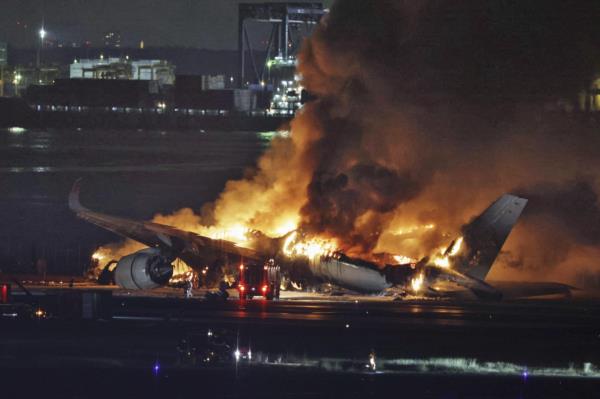
In a shocking incident on a Tokyo runway, new details have emerged about a fiery and deadly crash involving a Japan Airlines jet and a Japan Coast Guard plane. Alarming reports indicate that the red warning lights, intended to prevent planes from taxiing onto the runway, were not functioning at the time of the accident. Transcripts of the communication between air traffic control and the planes have also been released, shedding light on the events leading up to the catastrophic collision.
The transcript reveals that air traffic control had instructed the Coast Guard plane to 'taxi to holding point' just a minute before the passenger plane was cleared to land. However, there is no indication that the Coast Guard plane had been cleared for takeoff. These crucial four minutes, between 5:43 and 5:47 p.m., are now the focus of the investigation into this harrowing crash.
Passenger Aruto Iwama shared a terrifying firsthand account of the incident, captured on video from his window seat. He described feeling intense shaking upon landing and witnessing sparks flying outside the aircraft, which quickly burst into flames. Within seconds, the cabin filled with smoke. As panic ensued, flight attendants resorted to using megaphones to guide passengers to safety, as the onboard communication system had failed. Some emergency exits were also obstructed, but remarkably, the crew managed to evacuate all 367 passengers, including eight infants, unharmed.
Tragically, five members of the Japan Coast Guard lost their lives in the collision. The investigation is now honing in on potential miscommunications between air traffic control and the two planes. The released cockpit audio confirms the tower's instruction for the Coast Guard flight to taxi to a holding point, while simultaneously giving clearance for the commercial flight to land. The transcript and audio raise important questions about the location of the Coast Guard plane and why the Japan Airlines pilots did not abort the landing, given the clear visibility at that time.
The remnants of the burned-out Airbus A350-900, still sitting on runway C, have become a somber reminder of the catastrophe that was narrowly averted. Investigators, including technicians from Airbus, have arrived at the scene to assist Japanese authorities in combing through the wreckage in search of the cockpit voice recorder. This crucial piece of evidence may hold vital clues as to what exactly transpired in those fateful minutes.
As we await further statements from the Japan transport ministry regarding the malfunctioning runway lights, it is unclear whether the plane inadvertently moved too far onto the runway, potentially contributing to this tragedy. Amidst the wreckage, the remarkable survival and actions of the flight attendants during this perilous ordeal shine through as a testament to their professionalism and heroism. It is indeed a miracle that, despite the loss of life, none of the passengers on board the Japan Airlines jet sustained serious injuries.
As the investigation unfolds, authorities and the aviation industry will strive to learn from this incident and implement necessary measures to ensure the safety of future flights.







